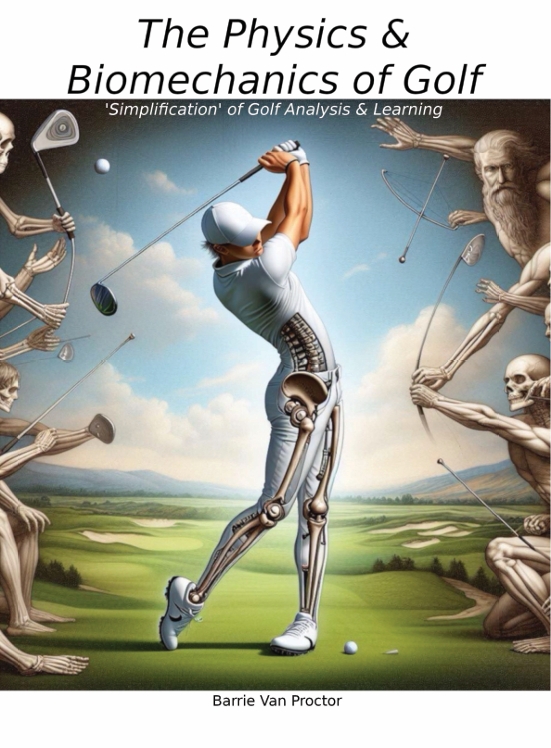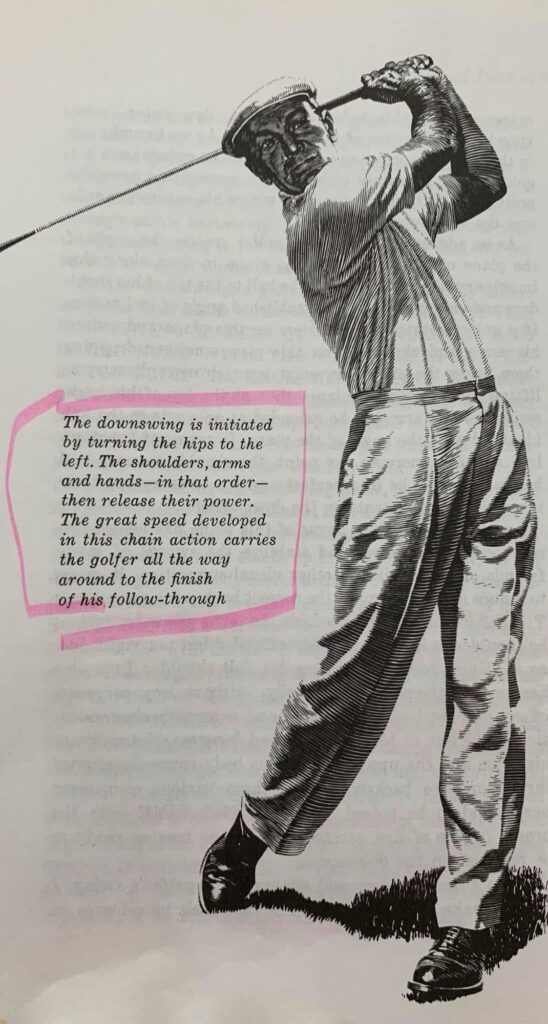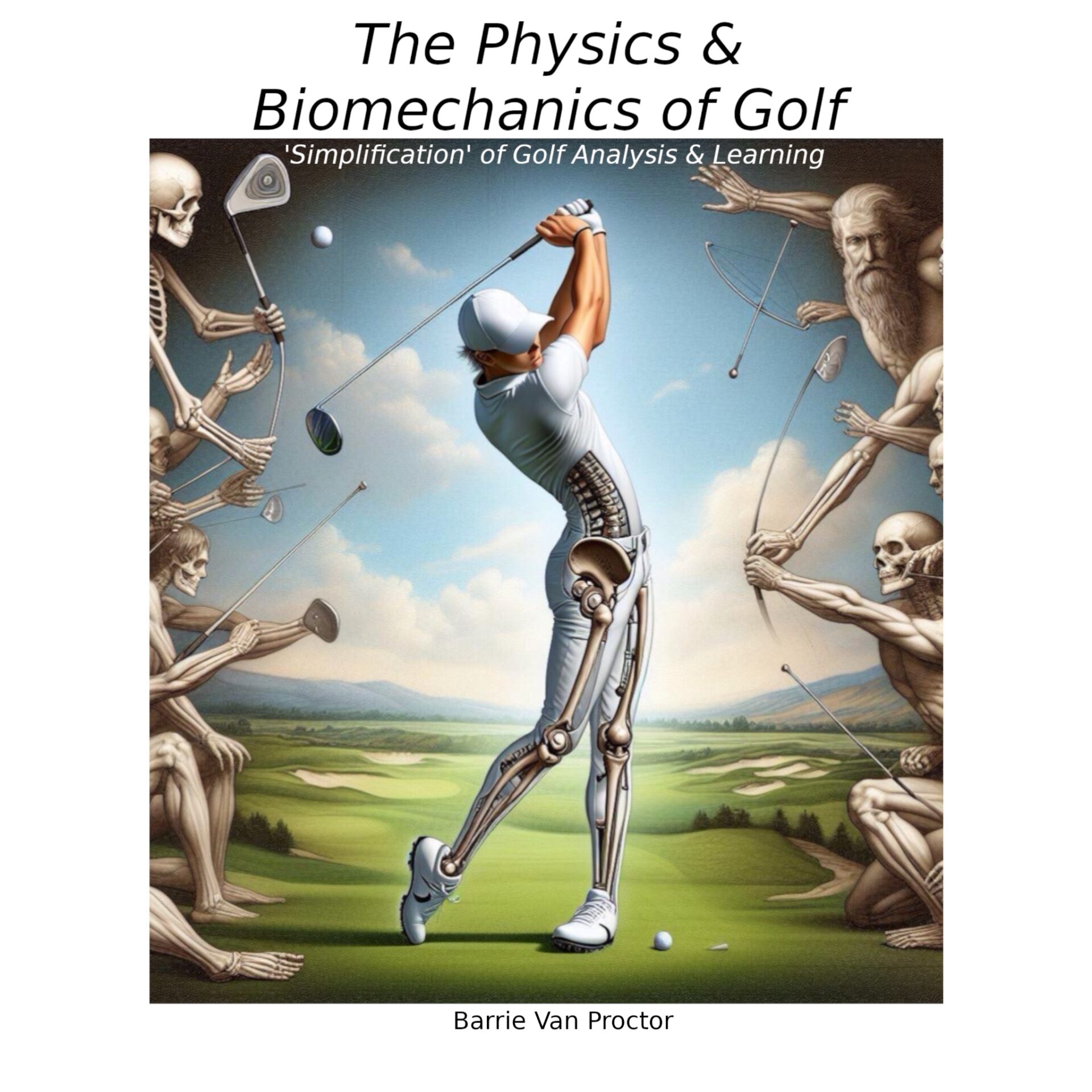Your basket is currently empty!

Ben Hogan’s ‘The Five Fundamentals of Golf’: A Biomechanics Perspective
A week or so ago I stumbled across a popular Facebook page dedicated to Ben Hogan. It is incredible how influential Hogan’s musings on the game still are. The Five Fundamentals of Golf, which was actually conceived of five separate articles or essays, is widely regarded as one of the most influential sports publications of all time, and is considered the template for contemporary golf instruction books that followed.
This week’s blog entry is based on my response to the below image, clipped onto a post on that Facebook page. What Hogan describes here is the ‘kinematic chain’ in a biomechanics sense, and more broadly the ‘summation of force principle’. But his assertion that this (accrued energy) carries us all the way into follow through is incomplete. For example, it excludes later phase lead hip angular momentum supported off of the lead leg (quadricep). It also excludes maintenance of the pivot through impact via trailside extension. This should occur once lead oblique contraction driving the trail hip is all but spent. That is the much abbreviated descriptor of omitted biomechanics therein.

A further post cited Hogan’s ball position at setup, being as it was, inside the lead heel for all clubs, with an incrementally ‘closed’ stance (ascending from wedge to Driver).
‘Academic study has established that a leadside setup significantly curtails pivot (relative to a trailside ball position).’
The Science is solid and both logically and intuitively if the ball is trailside, one must surely pivot more (quickly) to return back to the ball-target line at impact. Hogan’s rotational dynamism was achieved despite his setup preference in this regard. This was possible in part I suspect by his rare athleticism, possibly and particularly with respect to his ‘core’ musculature’s characteristics and composition.
Hogan himself was widely regarded by his peers as the greatest striker of the golf ball ever. His achievements speak for themselves (there are those who denigrate, suggesting a ‘lack of depth’ to the competitive field in the post war era). Even more though, these achievements were themselves attained in a time of global unrest and uncertainty. He won his first major in the year following the end of The Second World War, during a period when travel was not nearly as easy as it is now, transatlantic flight for example was not commonplace until the 1960s. Hogan also had significant personal hurdles, including injury from a near fatal car accident in 1949. In 1953 he appeared at The Open for the first and last time, picking up The Claret Jug, along with winning The Masters and US Open that year (he was unable to play the fourth major, The PGA Championship, its’ schedule clashed with The Open that year).
In my book ‘The Physics and Biomechanics of Golf’ I note:
‘The five fundamentals’… are in the main how Hogan, a unique and uniquely talented athlete went about this, they are not universally applicable in the sense of scientific principle.’
Tracking down video of Hogan, what is apparent is how dynamic he was from the top, despite a deliberately strictured setup, especially with respect to arm articulation. Dynamism and dynamic learning is key to developing a mechanically correct, properly sequenced swing. Idiosyncrasies of setup either help or hinder this. A natural, or ‘neutral’ setup is a more assistive base to start. Hogan’s setup idiosyncrasies were born of a predisposition toward a severe duck, or diving hook.
Nevertheless, I am not certain his well deserved regard as a player and the affection carried with it, explains the reverence that his seminal text is afforded. If Hogan’s instruction was that on point, then why has his swing so rarely been duplicated at the top tier, and especially in the modern era? A great book it may be, but very much of its’ time I think, especially from a biomechanics perspective. Little was fully understood of swing mechanics until the advent of high frame rate digital video (I undertook my undergraduate project ‘The perception of biological motion’ in 1999 and the university’s video capture studio recorded at a paltry 25 frames per second, maximum!).
I am in no way trying to undermine Hogan’s achievement in writing ‘The Five Fundamentals’. In part it influenced my own book. But as with his peers at the time, Hogan’s technique was individualistic. Was there any great confluence of theory in coaching at this time? I am not so sure, in all likelihood many players were probably self taught. The style of tuition Hogan’s book conceived, I term ‘deconstructive’ analysis, in that dynamic motion is quantised into its’ (supposed) constituent parts. This is not the best way to learn complex dynamic motion, after all, descriptive way-markers and static poses as an instructor will often demonstrate to their pupil, are entirely deprived of dynamic forces.
Information regarding motion and muscle activations that precede and proceed a given position then, are not considered via ‘deconstruction’.
‘A golfer requires both sensory feedback (proprioception) and a base understanding of the physiology, forces and biomechanics involved.’
Speaking of which, I was flattered and enthused this week to pickup a follow from @MiracleSwing over on Twitter. Its’ author Christo Garcia I have followed on YouTube for many years. Christo is a scratch golfer who has modelled his swing and teaching methodology via study of Hogan’s work, his peers and contemporaries. His golf swing is as near comparable to Hogan’s as is likely to be seen, so much so I believe it has featured in sports documentaries. It is well worth checking out Christo’s content, irrespective of whether Hogan’s writings resonate or not.
Have a good week and all the best.
The Physics & Biomechanics of Golf

golfbiomechanics.net
We author, publish and sell our books here in the UK, along with our distributors including Amazon. As an Amazon Associate, ‘golfbiomechanics.net’ earns from qualifying purchases on affiliated products. This means that if you click on an affiliate link and make a purchase, ‘golfbiomechanics.net’ may receive a small commission at no additional cost to you. Thank you for supporting this website and helping us continue to provide the best and valuable content!
Discover more from golfbiomechanics.net
Subscribe to get the latest posts sent to your email.

Leave a Reply